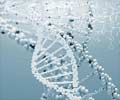A combination of stem cell and gene therapy may hold promise in arresting a lethal brain-wasting illness and may hold clues for the treatment of other genetic disorders, researchers said.
A combination of stem cell and gene therapy may hold promise in arresting a lethal brain-wasting illness and may hold clues for the treatment of other genetic disorders, researchers said.
The boys, both seven when treatment began in France, are beset with X-linked adrenoleukodystrophy, or ALD, a hereditary brain disease that slowly strips away layers of fatty acids protecting nerve fibres in the brain.Without treatment, ALD which only strikes males results in a downward spiral of physical and mental disability, and finally death. Few patients reach adolescence.
The disease's terrible toll was depicted in the 1992 film "Lorenzo's Oil", the true story of an American couple's tireless struggle to find a cure for their son.
"This is the first time that a very severe brain disease has been treated with efficacy by gene therapy," said lead researcher Patrick Aubourg, a professor of paediatrics at University Paris-Descartes.
Up to now, ALD patients were given bone marrow transplants, a technique hampered by the scarcity of donors and the risk of serious complications.
In the new treatment, bone marrow stem cells were harvested from the patients -- the boys, in effect, became their own donors.
Advertisement
In order to deliver the new, improved stem cells, the doctors devised a vehicle, or "vector," made from a modified and inactivated HIV virus.
Advertisement
HIV is the only known virus able to introduce a therapeutic gene into the nucleus of non-dividing cells, such as stem cells and neurons.
After 14 to 16 months, the disintegration of the brain's protective fatty acids, called myelin sheaths, had stopped.
And after two to two-and-a-half years, healthy ALD proteins were still detectable in the boys, both of whom showed neurological improvement.
In principle, the technique should result in the expression of the therapeutic gene "for life" because it is inserted into the chromosome, said Aubourg.
Gene therapy is not without risk, the researchers cautioned, and the new method may not be as effective with other diseases.
"There is still a lot of work to be done to make this gene therapy vector more powerful, less complicated and less expensive. This is only the beginning," Aubourg said.
ALD is a rare disease, with only three dozen cases reported each year in France, and 300 to 350 cases in the United States.
Source-AFP
SAV















